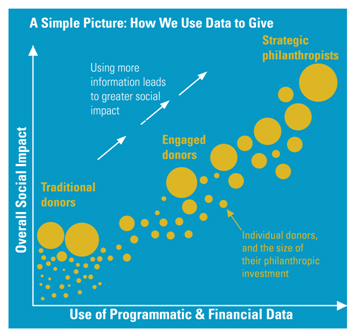How do we as a nonprofit sector decide which nonprofits are doing a good job and which aren’t, and how do we communicate that to current and potential supporters? Watch dog groups often rely on spending and growth data for their analysis, but as Anjali Deshmukh asks, “If an organization could prove to you that they could eradicate homelessness, would you care as much about what they spent on salaries and staplers?” This guest post and Anjali’s organization, Nonprofit Finance Fund, may have you re-thinking what the term “bottom line” means for your nonprofit, and therefore how you communicate your effectiveness to your supporters. ~ Kivi
Guest Post by Anjali Deshmukh of Nonprofit Finance Fund
Measuring social impact and nonprofit effectiveness has been the white elephant for our sector since its inception. Unlike for-profits, where the bottom line often defines success or failure in black and white, nonprofits live in a world of grey, evaluated on their success in achieving their mission and on how they raise and spend their money.
But when the solutions to social problems are so incredibly complex, it’s not easy to come up with models for standardized assessment that we can have confidence in. On top of that, every organization is structured differently and has different financial needs to support its mission. In part, this is why donors use online ratings systems. When we’re faced with a massive library of data and a limited amount of time, we will inevitably seek out the easiest way to get the answers we need – even if we know that the shortcut may oversimplify the picture. (Think Wikipedia!)
The problem is that the ratios most commonly used for rapid analysis, typically focused on spending or growth, are not accurate measures of either organizational health OR social impact. When nonprofit supporters use these metrics to make funding decisions, they contribute to a cycle that awards nonprofits for operating on razor-thin margins, ultimately distracting them from where their vision needs to be: on solving social problems. After all, if an organization could prove to you that they could eradicate homelessness, would you care as much about what they spent on salaries and staplers?
A Simple Picture of How We Give
 Making the right data easier to access and understand helps donors stay focused on what matters: the achievement of social impact. But data doesn’t factor into giving for everyone. On one end of the philanthropy continuum, many “traditional donors” make investments based on their passion for mission and their personal relationships.
Making the right data easier to access and understand helps donors stay focused on what matters: the achievement of social impact. But data doesn’t factor into giving for everyone. On one end of the philanthropy continuum, many “traditional donors” make investments based on their passion for mission and their personal relationships.
In the middle are the “engaged donors” who want data to inform their decisions, but don’t have enough time and money to go far beyond what’s readily available through online ratings. While they’re interested in data, they don’t do a comprehensive analysis to determine which organizations are the most stable and effective.
On the other end of the continuum are the “strategic philanthropists” who give based on a deep analysis of an organization’s impact and stability. They tend to invest a lot of money in fewer, high-performing organizations and are willing to spend more time to make sure their philanthropic dollars have the most impact.
So how do we move more of the “engaged donors” up the data continuum, so that, even though they may have less time to spend or money to give, their dollars still have greater social impact?
Financial SCAN: Nonprofit Analysis Made Easier
Our access to data is growing at an incredible rate. At Nonprofit Finance Fund (NFF), we think that engaged donors need online tools that improve their access to the right data and make that data easier to understand and use. To make this happen, we’ve been working with Guidestar to create a new data platform, called Financial Scan.
Financial SCAN doesn’t rate or rank nonprofits. Using data from IRS Form 990 returns filed by nonprofits, it creates dashboards and graphs that show a nonprofit’s financial condition over time. It analyzes data in a comprehensive, standardized way, without over-simplifying an organization’s story. Instead of focusing on spending patterns or growth rates, it uses metrics that are better correlated with an organization’s overall health and ability to deliver strong programs. It also allows users to compare a nonprofit’s key financial metrics side-by-side with up to 5 other nonprofits. On top of that, NFF has condensed its 30 years of advice into educational narrative to help users understand what the information means, why it matters, and how it can be used to make philanthropic decisions.
Financial Scan is new and evolving—one in a growing toolbox, including Philanthropy In/Sight, The Strategy Landscape, and Policy Map, to name a few. It’s certainly not a replacement for an audit and the nuanced knowledge of a financial expert, and it also must be paired with program impact data for a full picture of organizational effectiveness. But we believe that tools like this can support a culture of data driven philanthropy. More donors will be able to move up the continuum, accessing better data within the time and financial constraints that have held them back in the past.
Hopefully, improved data platforms can help re-frame the conversation around giving. Instead of asking “how is this organization using my philanthropic dollars?” we can be better equipped to ask ourselves: “how is my contribution helping this organization stay healthy so that it can create the change I want to see in the world?”
Anjali Deshmukh is Associate Director of Knowledge & Communications at Nonprofit Finance Fund. Previous to NFF, she has held a variety of communications-related positions, including working as a writer at LaPlaca Cohen, a strategic communications firm specializing in services to cultural institutions nationwide, and serving as an Americorps Vista volunteer at the Massachusetts Housing and Shelter Alliance. Ms. Deshmukh received her BA from Amherst College in 2001 in English and Fine Arts and an MFA from the Rhode Island School of Design in 2005. She is a Fulbright Scholar in the Fine Arts and continues to be actively involved in the arts.







